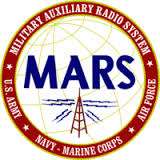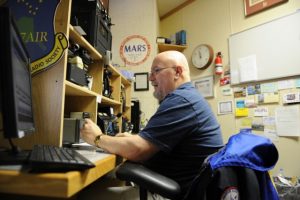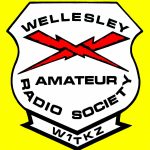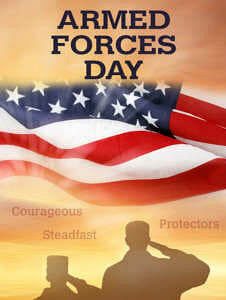There were 12 attendees at the seminar and they were as follows:
KB1EKN-Mark Duff Metro Boston ARES District Emergency Coordinator
WQ1O-Frank Olaughlin Cape Cod ARES District Emergency Coordinator
N1XTB-Philip McNamara Bridgewater ARES Team Member
K9HI-Phil Temples Eastern Massachusetts ARRL Section Manager
WA1IDA-Bob Salow Eastern Massachusetts Assistant Section Manager
N1LKJ-Jim Ward Eastern Massachusetts Section NTS Traffic Manager
N1BDA-Steve Telsey Middlesex County ARES District Emergency Coordinator
KW1U-Marcia Forde NTS EAS Chairperson
W1GMF-Gil Follett NTS Traffic Handler
W3EVE-Steve Schwarm Norfolk County ARES District Emergency Coordinator
N1FY-Carl Aveni Bridgewater ARES Emergency Coordinator
KD1CY-Rob Macedo ARES SKYWARN Coordinator for NWS Taunton
The first topic of the meeting was an ARES Program Overview. During the program overview, introductions were made and each person was asked about what they would like to get out of the meeting. The overview described how the ARES program has progressed over the last several years and how ARES has expanded relationships with different served agencies. It also talked about existing working relationships with MEMA and the National Weather Service. The presentation was well received and some suggestions on enhancements for the NWS Taunton station and for an additional project involving receiving AM Radio Stations was discussed and will be reviewed with NWS.
Following the ARES Overview, numerous items were discussed. Gil Follett-W1GMF requested what Clients/Served Agencies might need NTSD (National Traffic System Digital) or Packet support. This included the following agencies:
- Red Cross
- Salvation Army
- National Weather Service
- Cities/Towns ARES/RACES operations
- VOAD non-profit (Southern Baptist, Adventists, REACT and other smaller groups) (Mass. VOAD currently defunct due to internal issues.)
- MARS-Is there some way to try and plug into their digital system
It was noted in these discussions that any agency could need support in an emergency but the various agencies listed above would be some of the main agencies to service for potential ARES activations. Several additional ideas were also noted:
Instruct all NTS traffic that is going to a different ARES team either within district but especially outside of the district to pass their traffic via an active NTS traffic net using voice for all future ARES exercises.
- Utilize Packet more heavily across all parts of the Eastern Massachusetts section during exercises and actual activations.
- Add Health and Welfare traffic as part of the exercise and utilize active NTS voice traffic nets as well as Packet to pass this traffic.
- Add NTS Net and Net Control Operations to the Advanced Emergency Communications Workshop as follow-on to the Basic NTS Course offering in the Basic Emergency Communications Workshop.
- Assist NTS with utilization of a Laptop and LCD Projector capable of putting together Power Point slides to assist with getting more people involved with NTS.
- NTS Traffic Overview
Jim Ward-N1LKJ gave an overview of the voice and CW network. He explained what nets are run at run times and how the local nets interface with the region and area nets.
All these nets are available and need to be utilized further.
Gil Follett-W1GMF gave an overview of the digital system of NTS traffic. He put up a diagram using post it signs on the whiteboard to describe the Packet network. Learned that KW1U-Marcia is a Winlink PMBO node that can be utilized as part of the NTSD network. MMRA is attempting to put this together and we need to refer MMRA to Marcia for technical/logistical support.
Gil then walked through how to format a NTS message via Packet. With Digital, messages can be handled at any length within Gil’s system. Outside of Gil’s system, you have to follow normal NTS traffic rules. Keep in mind, that you can send regular messages at any length in and/or out of the Mass. system.
Gil-W1GMF discussed the NTS program. He discouraged the use of WinRC Packet because it’s only compatible with systems in Colorado. Gil discussed the NTS system being developed by KA1VGM and Beta tested by Gil. The system has most if not all of the bugs worked out. The system should be compatible with any BBS system and include the Winlink systems. The program should now be up on the KA1VGM web site. It is meant for anyone writing NTS traffic. It has several views for NWS messages, NTS traffic and other types of messages and will be passed to the various stations on the Packet network.
Several suggestions have come out of discussion:
1.) Have Jim-N1LKJ and Gil-W1GMF involved in ARES Meetings/exercise discussions. (Add them to all ARES Meeting invitations)
2.) For regular NTS nets, get listeners and anyone else to check into the net and encourage them to get out there and check-in and try to slow down on traffic for new people that are interested. Make sure that NTS people slow down to pass traffic to newcomers.
3.) Need to encourage Amateurs to utilize NTS traffic messaging via the Packet/Digital network even if its for routine traffic as its good practice for activations.
4.) Ask Jim to contact the local Net Managers, one night a month or one night a week to conduct a very basic training net to pass traffic. Jim to put together the scenario to run the basic NTS training across all the traffic nets.
5.) Jim asked that all ARES/RACES personnel encourage their members to check into the NTS Traffic Nets and generate and pick up traffic whenever possible and check into the local, and region traffic nets.
6.) Make sure NTS personnel are invited to the MRAS Meetings.
7.) Put together an all day NTS workshop that would encompass the existing slide sets from the basic and advanced Emergency Communication Workshops and include running a NTS Traffic Net on simplex or a repeater with everyone checking in using HT’s.
8.) Recommend NTS utilize Echolink/IRLP capabilities for in addition to their Region and Area nets and be part of the NTS national infrastructure.
9.) Supplying creative NTS traffic throughout the network via voice or digital nets. Use the key NTS traffic handlers to get this accomplished.
10.) Look into a formal DEC appointment for NTS.
After lunch, continued brainstorming continued and the first part of the afternoon focused on the ARESCOM proposals and the NTSD system. Marcia discussed the NTSD (National Traffic System Digital) System in reasonable detail. Marcia is able to get bulk traffic (2500 messages plus per month) sent across the national digital network using her WinLink node.
Marcia knows several members that are on the ARESCOM, which is a committee setup by Board of Directors concerning nationwide emergency communications and how to improve it. There are two NTS people are on this committee. ARESCOM is working closely with the Winlink Classic and the Winlink 2000 programs. The Winlink Classic program allows single user text messages using conventional forms of Packet. Winlink 2000 is an enhancement to Winlink Classic that would allow traffic from ARES clients including attachments, email and more. The protocol being utilized is called B2, which can handle attachments and has much higher compression rates and makes the message relatively secure.
The idea is to improve ARES capability to expand beyond the local area and to handle anything the client wants to send out. They want a flat “invisible†network with traffic coming in and out of Internet/Digital without knowing where the source is. The National Connection is through the Internet backed up with HF. It was noted that Doc-W1EO might be an excellent resource in the NTSD discussions going forward. The goal is to have regular messages and email with or without attachments to be able to be accepted through the NTSD system utilizing PMBO’s (Participating Mail Box Operators) when needed with the Winlink Classic program via Internet backbone or HF backbone whenever needed.
The EMCON proposal was proposed by W3YVQ-Jim from the Baltimore, Maryland area. Marcia stated that in direct discussions with Jim, they do not consider what they are proposing to be an ARES-NTS merger although at times the document comes across like it should be an ARES-NTS merger. Marcia stated that there is a Message and Procedure Guide on the League web site concerning Winlink and the EMCON proposal and you can click on topics of interest to gather information.
Marcia-KW1U highlighted the following items from the proposal documentation and in direct discussions with W3YVQ-Jim, which is one of the NTSD/EMCON proposal writers:
- STM and SEC as separate organizations doing what they are doing.
- ARES will work with the agencies and that’s their primary responsibility.
- NTS responsible for the message handling network and meet certain criteria.
- SEC and STM should work together to establish the Emergency Communications Plan for the section.
Based on this discussion, the ARES-NTS Workshop participants drew the following conclusions:
- The ARESCOM Report/Proposal is very misunderstood by ARES and NTS leadership on what the changes would mean for ARES and NTS.
- The report needs to be streamlined, reorganized and reworded and should separate the ARES-NTS network alignment from the Winlink-Digital system technical documentation.
- Volunteer Resource Committee had very negative feedback on NTS. ARESCOM is far less negative on NTS. ARRL Board of Directors needs to decide what committee’s report is more relevant. Based on the fact that ARESCOM does not recommend NTS merge with a ARES, we recommend that ARESCOM apply pressure to the ARRL Board of Directors on preventing any merger of ARES and NTS.
- Recommend Board of Directors to clear-up miscommunication of ARES-NTS network realignment/further cooperation. State to all SMs that NTS IS a requirement and having a STM IS a requirement that must be upheld.
- Recommend that the Part 97 rule changes that would dissolve RACES be dropped. While this may happen at some point in the future by attrition, the ARRL should not advocate it as it could promote ill will from RACES groups that already feel threatened by ARES.
- After the NTSD/ARESCOM discussion, the participants discussed Gil’s recent issues with passing traffic to certain states that are blocking it as “SPAM” traffic. Phil-K9HI plans to confront some of the ARRL Section Managers that are allowing this behavior at the
- Dayton Hamfest in late May. Phil has recommended that all who attended the meeting be prepared to write complaints to Tom-K1KI, New England Division Director if necessary, to try and resolve these NTS problems as ARRL HQ and the Board have not responded on the issues that Gil is having. Phil also recommended to Marcia that ARESCOM apply pressure to the ARRL Board of Directors and HQ on this issue as well. Phil-K9HI plans on providing status reports on this issue.
Additional discussions surrounded increasing NTS participation. A suggestion was made to take a NTS net, record it and put it on the NTS web site and the ARES web site as well. There should be recordings of one voice net and one CW Net. After putting these recordings, commentary to explain the various portions of the NTS Net, voice or CW could be done as well. Jim and Gil will attempt to put together the recording via .wav or other audio type file that can be put on the web-site, put in workshops and bring to club meetings etc. Gil-W1GMF, Phil-N1XTB and Phil-K9HI will check with Elliot Mayer-W1MJ as he may be an expert in utilizing audio files and could help with breaking up the audio files to allow commentary to be put into the audio files to help describe what various items that happen in the net are so that Hams can learn about NTS Nets quicker.
The next item discussed was a recommendation on a potential name change from ARES to a more generic “Emergency Communicator, Emergency Communications team†type of name. The recommendation was taken under advisement for a future meeting.
Phil-N1XTB brought up a generic point about technical considerations of what MARS is running into for their digital system and how NTS may run into some of the same issues. Some corroboration between MARS and NTS in this area maybe very helpful for both Digital networks to work well and potentially have a path to connect to each other if needed.
The next meeting will be scheduled in the late Summer/Fall of 2004 to review actions generated from this meeting and assure that the plan for expanding the cooperation of ARES and NTS goes to the plans laid out during the meeting. The next meeting will also assure that the recommendations to the ARRL Board of Directors and HQ on ARES and NTS are heard and taken into account on the future of ARES and NTS going forward.
 A Taunton, MA amateur is among twelve US Army Military Auxiliary Radio System (MARS) volunteers being honored with gold-level recognition for the President’s Volunteer Service Award for 2020.
A Taunton, MA amateur is among twelve US Army Military Auxiliary Radio System (MARS) volunteers being honored with gold-level recognition for the President’s Volunteer Service Award for 2020.



 From ARRL Web:
From ARRL Web:
 From ARRL Web:
From ARRL Web:

